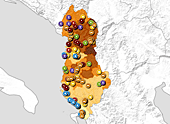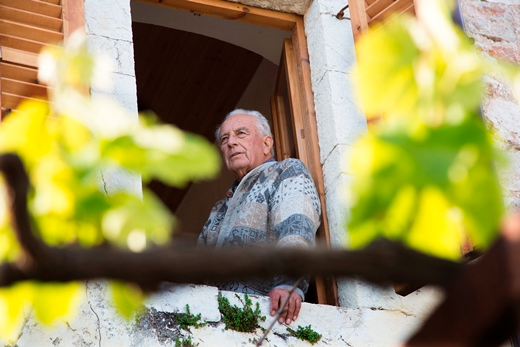Albania is renewing its vital environmental and community infrastructures in order to boost the country’s potential for tourism in the nature-rich south coast. The improvements aim at upgrading coastal village conditions, protecting nature and cultural endowment and traditions, and attracting more local as well as international tourists in a sustainable way.
Lluka Nikollori worked and lived far away in the capital for years, while his childhood home, in Albania’s coastal village of Ilias, slowly deteriorated.
But now he’s back, and –at 80– is embarking on a new adventure.
A small grant helped him cover most of the costs for a new roof and facade on the century-old structure, using traditional architectural elements.
A grant is also paying half of what it is costing him to turn the place into a small bed and breakfast.
“There are two things I am doing this for. One, it is in order to maintain the legacy of my childhood home. And two, I will benefit economically,” says Nikollori.
The small grants which helped Nikollori to transform his home is part of Albania’s Coastal Village Conservation and Development Program, supported by the World Bank and other international donors.
The multi-faceted program aims at developing and promoting tourism in a sustainable way along Albania’s potentially tourist-rich southern coast line, through improving community infrastructure and promoting local construction traditions.
The program uses inclusive approaches to sustainable development of the coastal areas.
Under a community development component of the project, Nikollori and other coastal village residents applied for grants to renovate their old roofs, facades and other basic structures, on condition the renovations comply with local architectural tradition, and that the beneficiaries contribute to the cost of rehabilitation.
“I was in need of a new roof and if it hadn’t been for the program, I would have ended up paying a lot more and would have gotten less quality. I paid less and got a better roof,” says Kristofor Gjomemo, another Ilias resident.
Gjomemo and his wife received a grant that paid for 70 percent of their new roof, made of the same clay-style tiles their coastal village has used for generations.
Elpiniqi Gjikondi got a similar grant to retile her roof through the same program, in the coastal village of Qeparo.
“I like that it looks old, with the same old chimneys just as it was in the past. I like this,” she says.
More than a dozen villages in three of Albania’s coastal municipalities have benefited from the development program, which in addition to the renovations to houses, is also upgrading the village infrastructure, with water supply systems, new roads and newly paved village squares.
Such improvements are leading former residents to return, say village officials, like Qeparo village leader, Stefan Kokedhima.
“When people saw that the new water supply was being built, there were many requests to come back to return to the old village,” he says.
After years of working in hotels in other places, Nestur Vjero has finally returned to his coastal village of Vuno, where the development program gave him two small grants to renovate his ancestral home, and turn it into a small hotel.
in other places, Nestur Vjero has finally returned to his coastal village of Vuno, where the development program gave him two small grants to renovate his ancestral home, and turn it into a small hotel.
 in other places, Nestur Vjero has finally returned to his coastal village of Vuno, where the development program gave him two small grants to renovate his ancestral home, and turn it into a small hotel.
in other places, Nestur Vjero has finally returned to his coastal village of Vuno, where the development program gave him two small grants to renovate his ancestral home, and turn it into a small hotel.
“People here who have goats or, I don’t know, sheep and stuff, can sell their products, and all the fields of olives can give so much to the tourists too, like oil or olives,” Vjero says, adding that he hopes that soon he’ll be sharing his home –and his village’s other attractions– with incoming tourists whose money will benefit all!




Nessun commento:
Posta un commento